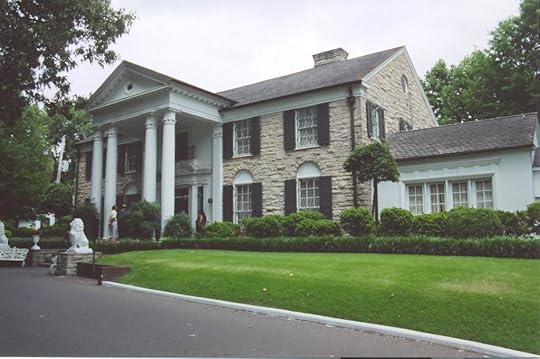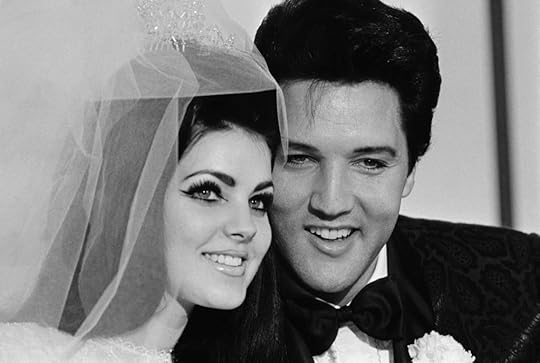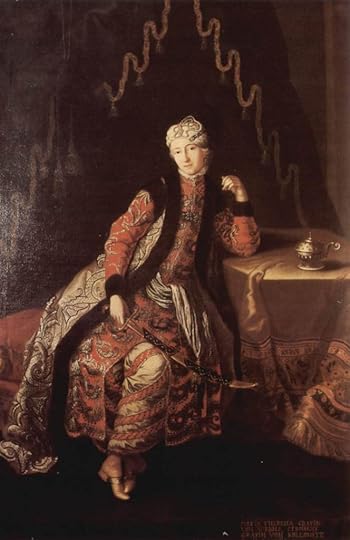Ripley Entertainment Inc.'s Blog, page 195
July 1, 2020
CARTOON 07-01-2020
June 30, 2020
Bizarre Elvis Facts That Will Leave You All Shook Up
Featured in Ripley's Believe It or Not!

When most people think of Elvis Presley, they usually think the “King of Rock and Roll,” or more simply, “the King.” Or they get “All Shook Up” thinking about his possible drug addiction or overdose, or even the conspiracy theories that he may still be roaming the Earth somewhere. But there are so many other tidbits about this bedazzled jumpsuit-wearing “Big Hunk O’Love” that the girls just “Can’t Help Falling in Love” with. Let’s rock and roll before these puns get to be a little “Too Much.”
Elvis’s first song was recorded at the age of 18 and cost him $4.
In 1953, Elvis paid $4 to record a song as a birthday gift for his mother. Unfortunately, Elvis’ mother never heard the song as the Presley family didn’t own a record player, and Elvis never released this tune publicly. A year later, the King followed up this mishap by recording “That’s All Right Mama.” And the rest was history; by 1956, he was Elvis.
Elvis Presley’s Graceland Mansion is the second-most visited home in the United States.
Following the death of Elvis, his ex-wife, Priscilla Presley, opened their estate for tours to the public. On average, nearly 600,000 fans visit Graceland to see Presley’s home, compared to the 1.25 million visitors of the White House, each year.

CC: Jan Kronsell
Believe It or Not!, Elvis bought the Memphis mansion for $102,500 in 1957 when he was only 22 years old. Today, Graceland belongs to Lisa Marie Presley, Elvis’s daughter, and the total economic impact on the city of Memphis from Graceland visitors is estimated to be $150 million per year or possibly much more.
Elvis was a seventh-degree black belt in karate.
Starting his training in Europe in 1958 while in the Army, Elvis studied martial arts until his death in 1977. He even showed off his skills in a 1971 encounter with the King of “Shock,” Alice Cooper, in a hotel in Las Vegas. At the request of Elvis, Cooper showed up to the hotel where he was greeted by Liza Minnelli, Chubby Checker, and Linda Lovelace. Upon arrival at the room, Elvis brought Cooper to the kitchen, opened a drawer, and handed him a loaded pistol, asking Cooper to put it to his head.
The little voice in Cooper’s head was conflicted. In an interview with Daily Mirror, he stated, “A little voice in my left ear was telling me, ‘Go on, kill him, you’ll always be the guy who killed Elvis.’ In my other ear was another voice saying, ‘You can’t kill him, it’s Elvis Presley, wound him instead, you’ll only get a few years!’”
Within seconds, Elvis’s perfectly-executed flying-kick sent the gun through the air, all while he tripped and pinned Cooper to the ground by his neck.
“That’s how you stop a man with a gun.” – Elvis Presley
Elvis inhaled his tooth cap while filming Jailhouse Rock in 1957.
Elvis’s third movie was the famous MGM film Jailhouse Rock. While sliding down a pole in the opening dance number, Elvis lost the cap off his tooth. Now lodged in his lung, Elvis required surgery while on set to remove it. This procedure required the separation of his famous vocal cords to fit the appropriate retrieval tool inside. Though he was a little hoarse for a few days following, Elvis’s recovery was fairly easy.

The irony of this situation? The Jailhouse Rock character Elvis was playing, Vice Everett, had an injury to his vocal cords hoping there would be no lasting damage to his singing voice.
Elvis was a natural blonde.
Elvis’s classic look as tall, dark, and handsome is not exactly all-natural. While tall and handsome certainly hold up, Elvis was actually a natural blonde until his late teens! Even after his hair began to darken with age, it never truly got to the shade we know and love. Before he could afford the expensive luxury of real hair dye, Elvis opted for a cheap, DIY alternative—shoe polish! Of course, later in his life, he upgraded to a signature mix of the real stuff: Miss Clairol 51D and Black Velvet, and Mink Brown by Paramount.
@elvispresley as a Blonde #graceland. pic.twitter.com/4RtZXTkPLO
— Kim Cattrall (@KimCattrall) March 22, 2013
Elvis’s jumpsuits gained about 50 pounds during his run.
When Elvis first started wearing his iconic jumpsuits in the early 70s, they are said to have weighed around 25-30 pounds each. In the later years, as they became more intricate with embroidery and jewels, some weighed in at about 75 pounds!
Elvis’s heaviest jumpsuit was his most expensive and most iconic, The American Eagle—otherwise known as, the “Aloha.” In all of its glitz and glamour, this suit cashed in at approximately $65,000. Today, it would cost four times that amount to make that same suit!

CC: Thomas R Machnitzki || The American Eagle or “Aloha” jumpsuit.
Elvis is the second most paid deceased celebrity.
Forbes’ latest annual list of top-earning deceased celebrities, measured by pre-taxed incomes from October 2018-October 2019, put Elvis in the second-place spot. In 2019, The King earned $39 million behind Michael Jackson, who earned $60 million. Back in 2007, Elvis snagged the number one placement, earning upwards of $49 million.
Despite being dead for over 40 years, Elvis still sells about 1 million albums each year.
Elvis had a twin brother.
Elvis was born just 35 minutes after his identical twin brother, Jesse Garon Presley. The two were born in their parents’ two-room house in East Tupelo, Mississippi. Jesse Garon, who was stillborn, was buried in an unmarked grave in Priceville Cemetry the next day. Though Jesse’s time was short, Elvis spoke of his twin throughout his life.
Elvis made his Las Vegas debut in 1956 and didn’t return to the Vegas stage until 1969.
Elvis first performed in Las Vegas on April 23, 1956 when he was just 21 years old. He was billed as “The Atomic Powered Singer” at the New Frontier Hotel. Though he was popular with teens around the country, he wasn’t your typical Vegas entertainer.
He didn’t perform on a Vegas stage again for 13 years, but he did return back to Las Vegas a few different times before his comeback in 1969—including to film the hit movie Viva Las Vegas in 1963 and to marry Priscilla in 1967.

5/1/1967-Las Vegas, NV- Singer Elvis Presley and his bride Priscilla Ann Beaulieu, pose for a photograph following their wedding at the Aladdin Hotel. Presley, 31, met his 22-year-old bride when he was stationed in Germany during his Army service.
Elvis’s Vegas comeback show on July 31st, 1969 was one of his most iconic moments as a performer. He then went on to sell out 837 consecutive shows through December 1976, before his death.
Elvis never learned to read music, nor did he write or compose a single song.
Elvis recorded more than 600 songs in his career and did not write a single one. It’s said that he never allowed himself to be tied into one style, so he recorded songs written by dozens of different composers. This left opportunity to bring his own brand of emotion, energy, and feeling into his music. On some of his records, he is listed as a co-writer, due to his label demanding certain songwriters to give up 50% of the credit before Elvis began recording it.
Fifteen of Elvis’s 600+ song titles share one common similarity.
Here’s a hint: Blue Suede Shoes, Blue Moon, When My Blue Moon Turns To Gold Again, Blueberry Hill, Blue Christmas, Blue Moon of Kentucky, Blue River, Blue Hawaii, Milkcow Blues Boogie, Mean Woman Blues, G.I. Blues, Moody Blue, Something Blue, Indescribably Blue, and Blue Eyes Crying in the Rain.
Elvis only appeared in one commercial during his career.
In 1954, Elvis agreed to film a commercial for Southern Maid Donuts. Broadcast during the Louisiana Hayride, he agreed to sing the jolly jingle in exchange for a box of hot glazed donuts. He sang, “You can get them piping hot after 4 p.m., you can get them piping hot, Southern Maid Donuts hits the spot, you can get them piping hot after 4 p.m.” Unfortunately, the commercial was never released.
Besides commercials, Elvis made 17 major television appearances and starred in 31 movies. In 2004, a jukebox musical, All Shook Up, was released with music from Elvis Presley. However, the movie featuring the most Elvis tunes is Disney’s Lilo & Stitch. This animated feature hosts seven Elvis hits—more than any movie Elvis starred in himself!
Elvis never performed outside of North America.
Aside from a small handful of concerts in Canada in 1957, Elvis has never performed on foreign soil. While the exact reason has not been confirmed, many sources believe it was decided by his manager, Colonel Parker. It’s said that he turned down offers for Elvis to perform abroad because Parker was an illegal immigrant, and he feared he would not be allowed back into the U.S. following a tour. Interesting enough, about 40% of Elvis’s music sales have been from outside the United States.
Elvis bought Franklin Roosevelt’s presidential yacht.
Known as FDR’s “floating White House” from 1936-1945, the 165-foot Potomac was originally a U.S. Coast Guard Cutter. After the president’s death in 1945, the ship had a series of owners before Elvis bought it for $55,000 in 1964. Only in his possession for a short time, Elvis donated the ship to St. Jude’s Children’s Hospital where it was sold to raise money for their medical efforts.

“The Floating White House” || CC: Dennis Jarvis from Halifax, Canada
Elvis Presley will forever go down as one of the most iconic performers of the 20th century. And while there are so many other interesting facets of his life, we “Thank you, Thank you very much” for learning just a few of the King’s more obscure facts with us.
In true Presley fashion, Elvis has left the building.
By Michela Pantano, contributor for Ripleys.com
EXPLORE THE ODD IN PERSON!
Discover hundreds of strange and unusual artifacts and get hands-on with unbelievable interactives when you visit a Ripley’s Odditorium!
Source: Bizarre Elvis Facts That Will Leave You All Shook Up
CARTOON 06-30-2020
June 29, 2020
The Cursed Hope Diamond And Its Many “Victims”
Featured in Ripley's Believe It or Not!

Hotly contested debates still swirl around the movie Titanic (1997). Researchers continue to question what really sank the ship. A documentary in January 2020 argued that a coal fire weakened the hull. And fans as famous as Brad Pitt wonder whether Leo could have fit on the door. (Sorry, Kate, but we think the answer’s an obvious YES!) Of course, one of the show stoppers of the film remains the so-called “Heart of the Ocean.” It took everyone’s breath away in James Cameron’s movie and contributed to its nostalgic ending.
But did you know that a real-life jewel inspired the “Heart of the Ocean”? And unlike the movie’s stunning stone, the actual one, known alternately as the Hope Diamond and Le Bijou du Roi (The King’s Jewel), comes with plenty of bad mojo.
Here’s what we know about the Hope Diamond and those who may have fallen victim to its curse.
The Eye of a Hindu Deity
As tales go, the Hope Diamond legend proves titillating, spine-tingling, and entirely lacking in evidence. Nevertheless, it provides the ultimate cursed-jewel origin story. In 1666, Jean-Baptiste Tavernier stole a 115.16-carat blue diamond eye from a statue of the Hindu goddess Sita. Alternate versions claim he acquired it from a crooked priest.

Portrait of Jean-Baptiste Tavernier by Nicolas de Largillière (c. 1700).
Devotees of the temple were far from impressed. In retaliation, they placed a curse on whoever possessed the gem, supposedly launching a series of unfortunate events that would impress Lemony Snicket. Named the Tavernier Blue, the diamond was later recut, birthing numerous other jewels, including the infamous Hope Diamond.
The Tavernier Blue
Tavernier described the jewel as “violet” (a synonym for blue at the time) and of the highest clarity. A trader and traveler, he returned from his sixth voyage to India with the blue beauty. Some believe Tavernier sourced it from the Kollur mine in the Guntur district of Andhra Pradesh in 1666. These details remain up for debate, however.
Tavernier detailed the blue gem in his travelogue, The Six Voyages of Jean-Baptiste Tavernier (1678), providing detailed illustrations of the cut and quality. In 1668 or 1669, he sold this namesake jewel to King Louis XIV of France for a crazy bargain, 220,000 livres. The stone was valued at twice that amount! Why would Tavernier part with the diamond for so little?
As author Richard W. Wise notes in The French Blue, Tavernier received a patent of nobility in the deal. (Such patents cost between 400,000 and 500,000 livres at the time.) What’s more, doing business with the king came with priceless publicity. And when you consider the state of the economy in 17th century Europe, Tavernier had few clients to choose from.
The Blue Diamond of the Crown of France
Some rumors claim Jean-Baptiste Tavernier died of a raging fever not long after returning from India. To make matters worse, wolves or wild dogs ravaged his corpse. While fantastic supporting evidence for the curse, other accounts say the jeweler lived to the ripe old age of 84. If the jeweler’s bones didn’t become dog treats, you could argue that the stone bestowed him with an abnormally long life.
Of course, the so-called trail of death would continue. After purchasing the Tavernier Blue, Louis XIV hired Jean Pitau to recut the crudely-shaped triangular stone in 1678. Pitau’s work resulted in a 67.125-carat jewel that royal inventories listed as the Blue Diamond of the Crown of France. The king wore the stone set on a cravat pin of gold.
On a special occasion, Nicholas Fouquet, a favorite of the king, wore the diamond. Shortly after, the king accused him of embezzlement, and Fouquet spent the rest of his life in the fortress of Pignerol hanging out with the likes of the Man in the Iron Mask. Of course, Fouquet’s extravagant lifestyle didn’t help his case any. Nonetheless, Fouquet’s downfall would fuel the curse.
As would the deaths of almost every legitimate child Louis XIV sired. The king’s excruciatingly painful and stinky end by gangrene in 1715 also added to the legend. Were child mortality and necrosis common in the 17th and 18th centuries? Absolutely. Nonetheless, the curse of the Hindu god proved a more compelling explanation.
Toppled Kings and Murdered Jewelers
Louis XVI and Marie Antoinette eventually inherited the French Blue. By 1793, their heads rolled, and all but one of their children met grim fates. In the French Revolution’s turbulence, the French Blue disappeared. It eventually re-emerged as a 45.52-carat stone recut to prevent identification.
In 1839, Henry Thomas Hope acquired the diamond, endowing it with his name. Despite the positive title, his heirs also complained of bad luck and sold it to settle gambling debts. After recutting the diamond again, Dutch jeweler Wilhelm Fals’s son, Hendrik, murdered him and stole the diamond. Hendrik later committed suicide. Another owner, Greek merchant Simon Maoncharides drove off a cliff perishing with his wife and son. Did the Hope Diamond cause any of these tragedies? No, but stories like this were about to make someone rich.
In the 20th century, famed jeweler Pierre Cartier owned the diamond and wanted to sell it to American heiress Evelyn Walsh McLean. But she didn’t care much for the stone. So, Cartier pieced together a tragic history for the diamond. It wasn’t very difficult considering the stone’s great age and the fact its human owners all proved mortal in the end.
For good measure, Cartier added new accounts of French royals eviscerated by mobs, Turkish Sultans deposed, Russian counts left penniless, and more. He knew something vital about his potential buyer. McLean believed bad luck items brought her good luck. Cartier’s ruse worked, and she purchased the stone.
McLean regularly wore the diamond. Some reports say she had a collar created so her Great Dane could sport it, too. Then, the trouble started. First, her mother-in-law died, and then her nine-year-old son. Soon, her husband left her for another woman before ending up in a mental hospital where he perished. At 25, McLean’s daughter died of a drug overdose, and financial ruin followed close behind. Forced to sell her newspaper, The Washington Post, Evelyn McLean died impoverished. Was this a case of Hindu idol revenge or self-fulfilling prophecy? We’ll let you decide.
The Diamond’s Final Resting Place
Harry Winston, Inc., of New York, purchased the Hope Diamond along with McLean’s entire estate jewelry collection in 1949. For ten years, the stone toured the world with other precious gems known as The Court of Jewels exhibition. Funds from the show went to charity.
Because of the jewel’s rare and unparalleled beauty, Winston decided to donate it to the Smithsonian Institute. He mailed the gem first-class for $145 in insurance and $2.44 in stamps. The balance for the insurance fee was a whopping $1 million. James Todd, the mailman who delivered the package, would later add to the jewel’s infamy. After the delivery, he claimed his wife died, his leg got crushed, his dog was strangled, and his house burned to the ground.

CC: Mbalotia via Wikimedia Commons
Not surprisingly, the Smithsonian has become the Hope Diamond’s final resting place. One of the most famous jewels in the world, people remain intrigued by its lethal reputation and are satisfied to keep this “blood diamond” at a distance. That said, Cartier profited from the curse when he sold it to McLean, and the diamond’s terrible reputation continues to draw crowds to the Smithsonian.
By Engrid Barnett, contributor for Ripleys.com
EXPLORE THE ODD IN PERSON!
Discover hundreds of strange and unusual artifacts and get hands-on with unbelievable interactives when you visit a Ripley’s Odditorium!
CARTOON 06-29-2020
June 28, 2020
CARTOON 06-28-2020
June 27, 2020
CARTOON 06-27-2020
June 26, 2020
Deadly Serious Photography Trends Throughout History
Featured in Ripley's Believe It or Not!

The earliest known surviving photograph was made in the year 1826 by a French inventor named Joseph Niepce. This original photo was captured in asphalt on a pewter plate and took an exposure time of eight hours. Nowadays, we have trouble getting our families to sit still for eight seconds! But before there were coordinated khaki outfits and continuous shooting settings, people took to photography for a much spookier, and at times, morbid, reason.

View from the Window at Le Gras 1826 or 1827, believed to be the earliest surviving camera photograph. Original (left) & colorized reoriented enhancement (right). Photo by Jonnychiwa via Wikimedia Commons
So, that’s where we began—pewter plates and eight hours of development. But, let’s move on to where we ended up going. In the 10-year time span between this grey photograph and the Victorian Era in the late 1830s, many advances were made in the world of photography. While the photos developed much clearer than the original pewter, a few things did stay the same—such as the long exposure times.
Post-Mortem Childhood Portraits
In the mid to late 1800s, the Civil War was brewing, and America was forced to prepare for an avalanche of deaths to follow. Unfortunately, death was becoming more of a commonplace than anyone could have imagined, especially among young children. Aside from the upcoming war, mortality rates for children under five sat just above 40%.
In these unfortunate circumstances, there were a multitude of ways to grieve the losses of loved ones. Now more than ever, people looked to photography for comfort. While oil paintings were only affordable to the wealthy, photographs emerged as a somewhat cost-effective way to remember loved ones after they passed. Lost children became particularly popular subjects of these photos.
Deceased children were sometimes posed with parents, alone, or with siblings. These post-mortem shots often served as the only reminder of what someone looked like, as the technology to snap a few pictures of your kids on a daily basis was simply not at-the-ready. While many might be photographed with their eyes closed to look as though they were sleeping, some photographers would fix the eyes open, pose them in action, or even paint the pupils in later.

And while grieving children was common, of course, many people were grieving the loss of their spouse, siblings, or other adult figures as well. In comparison to the technology today, early cameras may seem rudimentary to many. At this time, however, cameras were mysteries of science to most people, and of course, this fascination led to an industry taking advantage of grieving families.
Ghost Photography by Mumler
Photographer William Mumler paired up with his medium wife to sell photos of deceased family member’s spirits throughout the 1860s. Likely using a combination of double exposure and painting, he would insert the “ghost” of people’s children, wives, or husbands into the photos.

John J. Glover with “ghost” of an old lady by William Mumler
People had very little reference for judging what a real photograph should look like, making them easy prey for this new technique.
A Mother’s Game of Hide-And-Seek
As years passed, the exposure time for photos was certainly shorter than eight hours, but it was still a difficult task getting people to sit still for a while the camera did its work—especially children. Instead of distracting the child with a squeaky toy and baby talk, mothers actually sat in the photos with their children but were often “disguised” or hidden.
There were a few reasons why mothers chose to cover themselves this way. The first is the most obvious: mothers needed their children to sit still for the long exposure times so they held the babies in their laps to produce as little movement as possible. Another belief is that the trend started because parents wanted to create “an intimate bond between the child and the viewer,” thus, leaving the mother out of the equation. One last theory stems from the fact that, in the Victorian era, photographing a loved one was such a rarity. Parents wanted images of their children alone that they could use to send to family members.

Everything from the spooky to the morbid to the somewhat clever—photography has certainly evolved over the past 200 years. We hope you enjoyed this little snapshot of history. For more topics like this one, and many others, be sure to like and subscribe to our channel, and follow along with us on Twitch!
Source: Deadly Serious Photography Trends Throughout History
Man Raises Bugs In Broccoli To Become Beautiful Butterflies
Featured in Ripley's Believe It or Not!

This Week
[June 22-June 28, 2020] Perfect pitch(er) plants, the Godzilla of dust bunnies, caterpillar families, and the rest of the week’s weird news from Ripley’s Believe It or Not!
Performance for 2,292 Plants
The audience was firmly planted in their seats on Monday, when a full house graced the Gran Teatre del Liceu for its first concert since shutting their doors temporarily mid-March. Believe It or Not! Barcelona’s UceLi Quartet preformed for 2,292 plants at the opera house’s opening night! The string quartet serenaded its green guests with Giacomo Puccini’s “Crisantemi,” and even fiddle leaf figs and indoor snake plants around the world could tune in via a livestream. All plants in attendance came from local nurseries and will be donated to health care professionals at the Hospital Clínic of Barcelona as a way of recognizing their efforts and sacrifices made during the pandemic.
Welcome to Ohio Flavortown!
Tyler Woodbridge, a 32-year-old Columbus, Ohio, resident started a petition to rename the state’s capital after one of their very own—Guy Fieri. As a Food Network icon, Fieri’s classic phrase “Welcome to Flavortown” has made its way into nearly every episode of Diners, Drive-Ins, and Dives and Guy’s Grocery Games. But, fans of the Columbus-born celebrity admire Fieri for more than his contribution to the world of food, like his efforts to raise more than $20 million for restaurant workers during the COVID-19 pandemic. According to the , Woodbridge believes that the city of Columbus can be described as a “melting pot” of different cultures and nationalities, and the name “Flavortown” would honor the city’s “proud heritage as a culinary crossroads and one of the nation’s largest test markets for the food industry.”
The city of Columbus, Ohio, has already vowed to bring down its statue of Christopher Columbus. But thousands are hoping to erase the city’s connection to Columbus’ legacy even further by renaming it Flavortown in honor of Columbus native Guy Fieri. https://t.co/YRGyE2QnEC
— CNN (@CNN) June 23, 2020
The Largest Dust Bunny Ever is Coming for Us!
A massive dust cloud from the Sahara Desert made its way to the United States this week. Believe It or Not! it is the largest and most concentrated dust cloud in the past 50 years! Experts have dubbed it the “Godzilla dust cloud” and it is due to cover the entire Gulf Coast in all its dusty furry this weekend.
Trade winds regularly carry dust clouds from the Sahara across the Atlantic Ocean, and they play an important role, from building Caribbean beaches to fertilizing Amazon soil and putting the brakes on tropical storms. The current cloud, however, is abnormally large and affecting air quality.

Image: © NOAA
The World’s Oldest Heli-Skier
Gordon Precious of Ontario is a rad granddad. He celebrated his 95th birthday by setting a Guinness World Record for being the world’s oldest heli-skier. Precious took a trip to the Cariboo Mountains in British Columbia, where he was lifted by a helicopter to the top of a ski run and made his way down the mountain—his first run by helicopter in five years!
The Very Hungry [Man Finds] Caterpillar(s)
Ripley’s has come across many peculiar produce finds—from frozen frogs to black widows—but never have we ever come across someone who has taken in their hitchhiker and cared for it as their own. British media personality Sam Darlaston did just that with the seven caterpillars he found in his veggies! Documenting the entire process on Twitter, Darlaston decided to raise his caterpillars to maturity—from larva to chrysalis, and finally, butterfly.
It all started with one caterpillar found in his Tesco broccoli. He named it Cedric. First, Darlaston did his research and discovered that Cedric was a cabbage white, or cabbage butterfly. He crafted him a cute little home and gave him all the broccoli he could ever dream of.
Darlaston went back to Tesco, who refunded him for the cost of the caterpillar-contaminated broccoli. He used that refund to purchase more broccoli and, Believe It or Not!, unknowingly adopted five more caterpillars. To top it all off, Darlaston’s roommate’s broccoli also contained a caterpillar, so this Brady-broccoli-bunch grew to seven caterpillars overnight!
Joining Cedric was Broc, Olly, Carlos, Croc, Janine, and Slim Eric—all now wild butterflies!
Every little, quite literally, does help ! Thanks @Tesco
CARTOON 06-26-2020
Ripley Entertainment Inc.'s Blog
- Ripley Entertainment Inc.'s profile
- 52 followers










